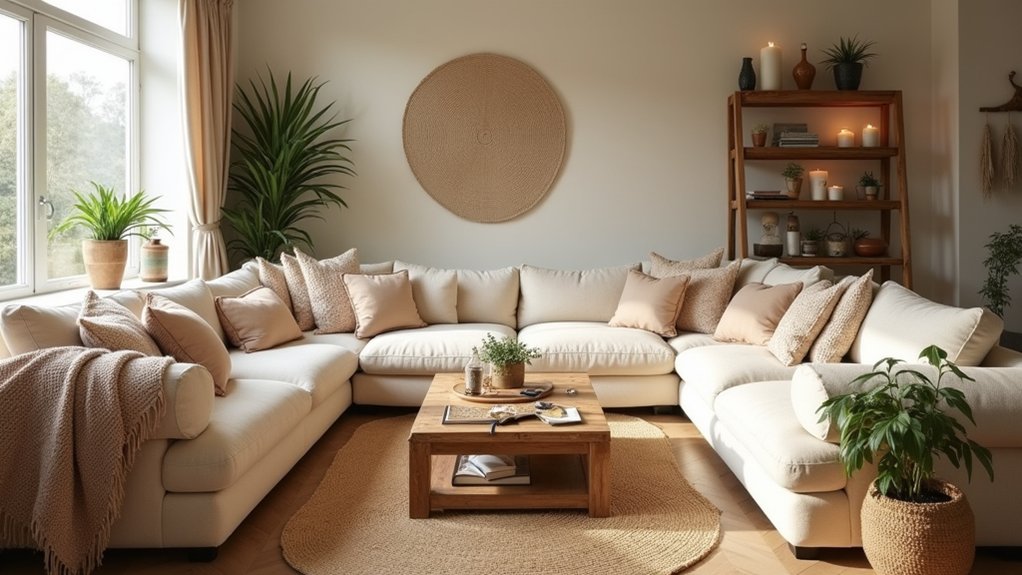
15 Beige Living Room Decor Ideas That Add Warmth and Texture
A beige living room gains depth and warmth through strategic layerings, such as plush sofas, chunky throws, and tactile rugs in varied tones from sepia to caramel. Expertly curated lighting—from warm bulbs to sheer-curtained windows—enhances the space’s radiance. Minimalist lines prevent clutter, while bold accent chairs, patterned prints, and greenery provide visual intrigue. Metallic touches introduce refined luminosity, and statement furniture anchors the design. Explore further to discover more sophisticated ways to enrich your beige living room.
Key Takeaways
- Layer soft beige textiles, chunky knit throws, and patterned pillows to create warmth and add tactile and visual depth.
- Incorporate woven ottomans, rattan chairs, and textured rugs like jute to ground the space with natural texture.
- Use warm, dimmable lighting and maximize natural light with sheer curtains to enhance the cozy ambiance.
- Add greenery and metallic accents to introduce organic contrast and refined luminosity without overpowering the neutral palette.
- Feature a statement beige sofa or accent chair in velvet or linen for a cozy focal point with rich texture.
Layer Textures for Depth
A strategic blend of tactile elements is essential for infusing dimension into a beige living room. Design professionals recommend starting with a plush beige sofa as the anchor, establishing both warmth and a neutral foundation. To cultivate depth, introduce texture through chunky knit throws and intricately patterned pillows, adding layers without visual clutter. Woven ottomans and rattan furniture serve as key natural materials, seamlessly complementing the beige palette while enhancing tactile interest. The inclusion of metallic accents—such as gold or brushed nickel—delivers contemporary contrast and subtle luminosity. Layering soft rugs and linen curtains further amplifies the sensory richness of the space. Ceramic vases, with their artisanal quality, complete the composition, ensuring a sophisticated interplay of texture and enduring visual appeal in a modern beige living room. Incorporating natural materials and houseplants adds warmth and balance to the beige decor, fostering a harmonious and inviting atmosphere.
Warm Up a White Space
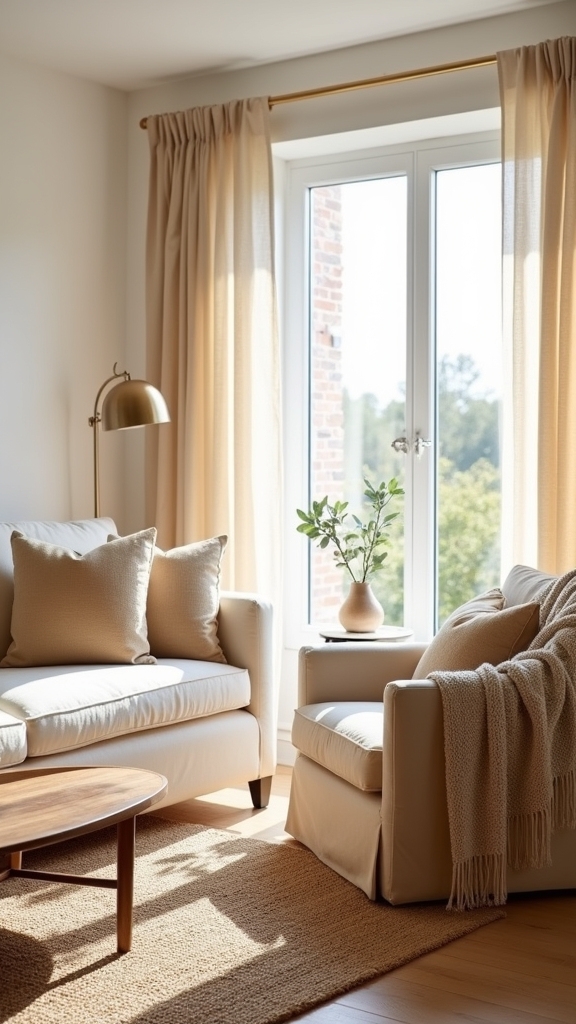
To transform a stark white living room, designers layer soft beige textiles, introducing tactile warmth and subtle tonal variation. Integrating natural wood accents—whether through sculptural furniture or flooring—brings organic richness and visual grounding to the space. Warm lighting, strategically placed, amplifies these elements, creating a cohesive and inviting contemporary aesthetic. Incorporating chunky knit throws offers additional warmth and texture, enhancing the room’s cozy ambiance.
Layer Soft Beige Textiles
While stark white interiors remain a mainstay of contemporary design, layering soft beige textiles introduces nuanced warmth and tactile richness that transforms the atmosphere.
Design professionals advocate for the strategic use of soft beige throws, plush cushions, and tactile rugs to soften the visual austerity of white living spaces. By combining textiles in varying textures—think velvet, linen, and cotton—the room gains dimension and comfort, elevating its sensory appeal.
Incorporating beige curtains not only diffuses natural light beautifully but also reinforces the room’s warm undertone. A soft beige area rug grounds the furniture arrangement, fostering cohesion and inviting relaxation.
Curating a mix of chunky knits with smooth linens guarantees visual depth, keeping the environment inviting and contemporary rather than sterile or one-dimensional.
Add Natural Wood Accents
Infusing a white living space with natural wood accents instantly introduces warmth and organic depth, counterbalancing the cool undertones of a monochromatic palette.
Expertly selected wood tones—ranging from pale oak to rich mahogany—enrich a beige living room with earthy tones and tactile textures, enhancing visual interest and elevating the overall ambiance.
Incorporating elements such as reclaimed wood coffee tables, wooden shelving, or architectural details like beams and paneling injects architectural character and rustic sophistication.
The juxtaposition of natural wood with soft beige furnishings creates a harmonious interplay of materials, aligning with current trends favoring sustainability and authentic finishes.
These thoughtfully layered textures guarantee the environment feels both inviting and curated, making natural wood accents a cornerstone of warm, textured beige living room design.
Use Warm Lighting
Amidst the understated elegance of beige living room decor, the strategic integration of warm lighting emerges as a defining element for curating ambiance.
Expertly chosen bulbs with an orange hue cast a soft glow, cultivating a cozy atmosphere that boosts the room’s inviting character. Contemporary design sensibilities favor layering light sources—overhead pendants, sculptural floor lamps, and accent table lamps—to create visual depth, while dimmable fixtures offer nuanced control over mood and brightness.
Minimal window treatments optimize natural light, blending seamlessly with artificial illumination to reinforce warmth and texture. Placing mirrors to reflect these warm light sources further enhances spatial brightness and cohesion.
This holistic lighting approach transforms a white or beige space, keeping the aesthetic on trend while ensuring comfort and sophistication.
Mix Multiple Shades of Beige

Contemporary interiors benefit from the strategic layering of light and dark beige tones, establishing nuanced depth and visual interest within the living room. Expert coordination of textiles—such as boucle throws, linen upholstery, and wool rugs—paired with complementary wall paint accentuates this tonal variation. This approach aligns with current trends favoring tactile contrast and understated sophistication in neutral palettes. Introducing natural fabrics and sustainable options like linen and wool not only enhances the cozy ambiance but also reflects eco-friendly design trends.
Layering Light and Dark
A sophisticated interplay of light and dark beige tones enhances living room design by introducing depth and dimension. Expertly layering multiple shades of beige—from subtle taupe to rich rust—transforms a neutral palette into a visually dynamic environment.
This approach leverages the inherent warmth of beige, establishing a serene yet inviting ambiance. Strategic placement of furnishings, such as a warm beige sofa juxtaposed with a deeper beige accent chair, amplifies visual interest without overpowering the space.
Textures further boost the scheme: a chunky knit throw, soft beige rug, or tactile cushions offer both comfort and nuanced layering. Accent pieces in contrasting beige hues act as focal points, ensuring cohesion.
The result is a trend-forward living space where depth, warmth, and textures coexist seamlessly.
Coordinating Textiles and Paint
Expertly mixing multiple shades of beige across textiles and wall paint enhances a living room with nuanced warmth and visual richness.
By coordinating textiles—such as throws, cushions, and area rugs—in varied soft tones from pale taupe to deep rust, designers prevent a flat, monochromatic appearance.
Utilizing beige paint as a foundational backdrop allows for layering diverse textures, including plush velvets and woven linens, which amplifies both tactile comfort and visual intrigue.
This method not only raises the perception of depth in small spaces but also creates a cohesive, on-trend aesthetic.
- Layer coordinating textiles in multiple beige tones to add dimension.
- Select beige paint that complements both light and deep textile shades.
- Introduce diverse textures for heightened warmth and contemporary appeal.
Create a Cozy Oasis With Rich Tones
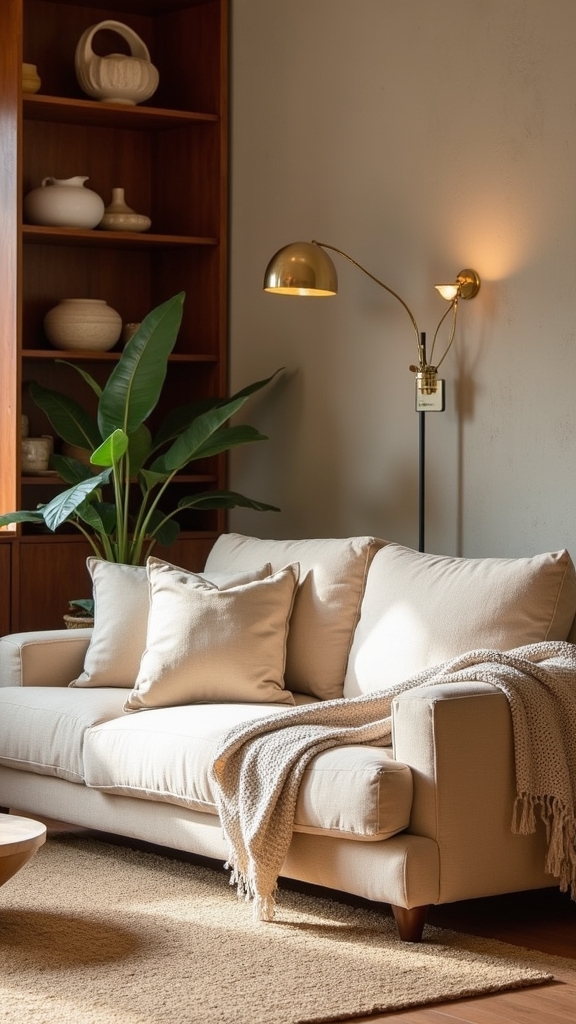
When layered thoughtfully within a beige living room, rich tones such as deep rust and chocolate brown infuse the space with an enhanced sense of warmth and intimacy. The interplay between a neutral palette and carefully curated rich tones raises the visual narrative, cultivating a cocooning atmosphere. Incorporating plush textiles—think velvet cushions or thick knit throws—adds dimensionality, while accent pieces in warm wood tones anchor the room, amplifying its earthy sophistication. Soft lighting, achieved through layered sources and warm-toned bulbs, further accentuates the depth of the color scheme. Integrating organic elements like terracotta vases introduces tactile contrast, harmonizing with the overall aesthetic. The table below demonstrates impactful combinations for a cozy oasis:
| Element | Material | Visual Effect |
|---|---|---|
| Cushions | Velvet | Tactile richness |
| Accent Table | Warm wood | Grounded warmth |
| Lighting | Soft, layered | Ambient glow |
Use Sepia and Caramel Hues
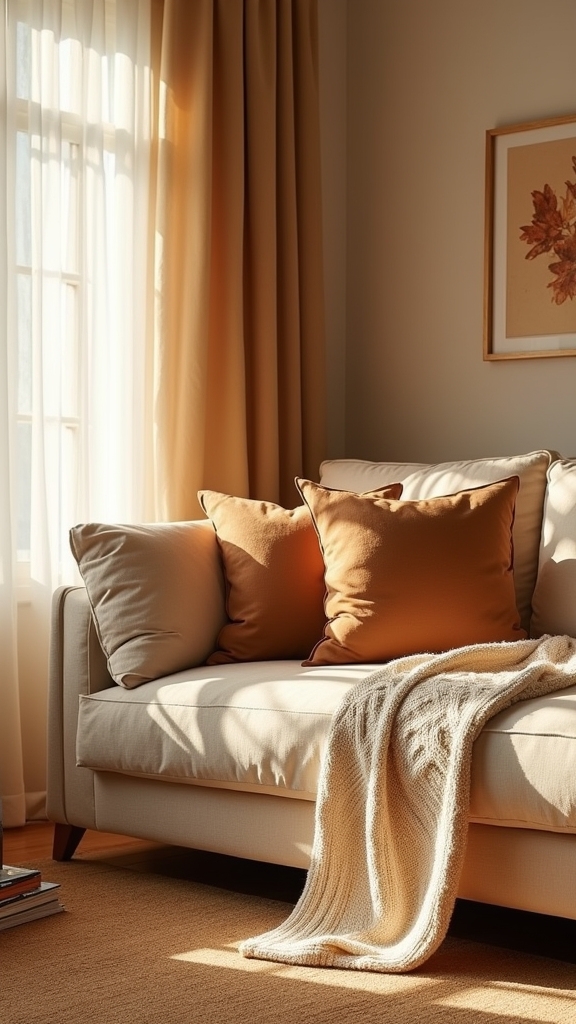
A strategic layering of sepia tones combined with caramel accents introduces warmth and nuanced depth to a beige living room, aligning with current trends favoring tonal richness. This approach prevents visual monotony while cultivating an inviting, cohesive palette. Expertly curated, these hues work harmoniously across textiles, furnishings, and decor to enhance the space with understated sophistication. Incorporating sustainable decor accents not only elevates the aesthetic appeal but also ensures durability and promotes eco-friendly living.
Layer Multiple Sepia Tones
Enhance beige living rooms by layering an array of sepia and caramel hues, a sophisticated approach that infuses warmth and visual depth into the space.
Employing a harmonious spectrum of neutral tones—from soft beige to rich chocolate—prevents monotony and raises the overall ambiance. The strategic use of sepia tones in upholstery, textiles, and accent pieces cultivates a warm and welcoming environment, while textural diversity—such as plush rugs and knitted throws—adds tactile interest and dimension.
This nuanced layering technique not only enriches the palette but also creates a nostalgic, inviting retreat.
- Pair sepia-toned velvet sofas with caramel accent pillows for visual contrast.
- Incorporate multiple textures—rugs, knits, and woven elements—to maximize depth and warmth.
- Use varying sepia hues to avoid a flat, uninspired look.
Caramel Accents for Warmth
Caramel accents serve as a refined strategy for introducing warmth and dimension to beige living room decor, especially when paired with sepia hues. The deliberate integration of caramel tones—through plush sofas, sculptural chairs, or even sleek ottomans—infuses the space with depth and visual richness.
Expert layering of sepia-toned textiles, such as tactile throws and cushions, enhances sensory appeal while sustaining a cohesive, harmonious palette. Decorative accessories in caramel, including vases and curated artwork, function as strategic focal points that punctuate the neutral foundation, offering visual interest without overwhelming.
This synergy of caramel and sepia hues with a beige base reflects current design trends, promoting versatility and effortless coordination with evolving palettes and textures, making the living room a consistently inviting and on-trend retreat.
Add Tactile Elements
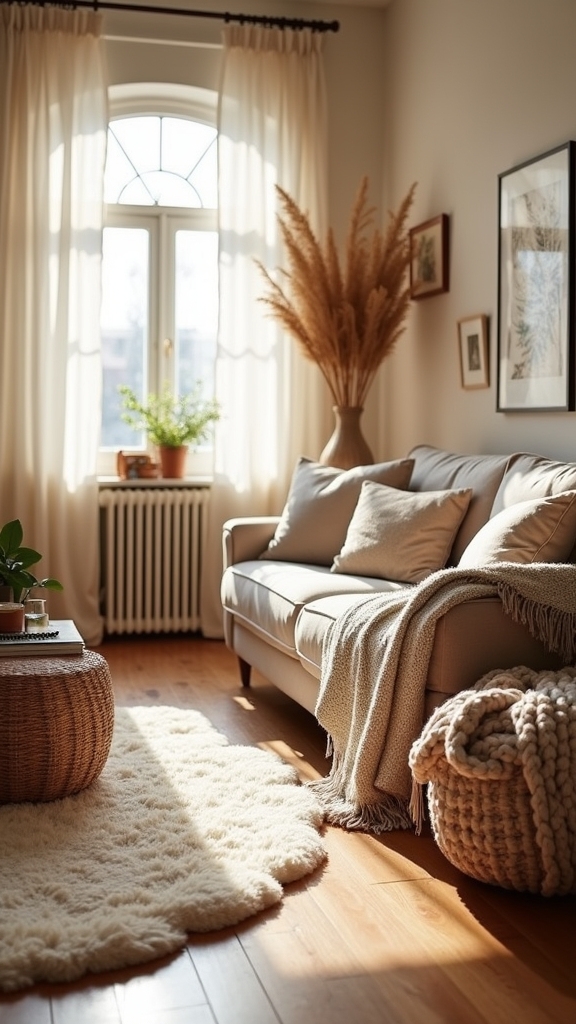
Infusing a beige living room with tactile elements enhances both visual interest and sensory comfort, aligning with contemporary design trends that prioritize layered textures. Thoughtful integration of plush fabrics, textured rugs, and woven elements redefines the beige palette, transforming it into a multidimensional sanctuary. By layering materials, homeowners can evoke depth and a curated feel that speaks to modern sensibilities. Generously textured curtains in linen or cotton not only filter light but also contribute to the room’s warmth and strategic softness. Incorporating eclectic furniture that blends vintage and modern pieces can further enhance the tactile and visual appeal, creating a personalized aesthetic. For ideal effect, consider focusing on these key components:
- Incorporate plush fabrics such as velvet or chenille for cushions and throws.
- Use textured rugs—jute or shag—to ground the space and add tactile depth.
- Select woven elements like rattan pieces for natural, complementary texture.
Incorporate Wooden Accents

Introduce organic sophistication by integrating wooden accents into a beige living room, a move that aligns with current design trends favoring natural materials and tactile contrast.
The juxtaposition of wooden elements—be it oak furniture, walnut beams, or pine paneling—infuses the space with warmth and depth, preventing the neutral palette from feeling flat. Layering various wood tones creates nuanced visual interest while maintaining harmony with beige hues.
Subtle decor details, such as wooden trays, picture frames, or sculptural bowls, punctuate the environment with texture and understated character. Architectural features like exposed beams or wall paneling further ground the space, complementing the tranquil atmosphere.
Pairing wooden accents with plush textiles amplifies the tactile dimension, ensuring the beige living room exudes an inviting, curated warmth. Reclaimed wood furniture offers sustainable allure and a storied past, making it an ideal choice for integrating natural materials into your decor.
Embrace Minimalist Beige Design
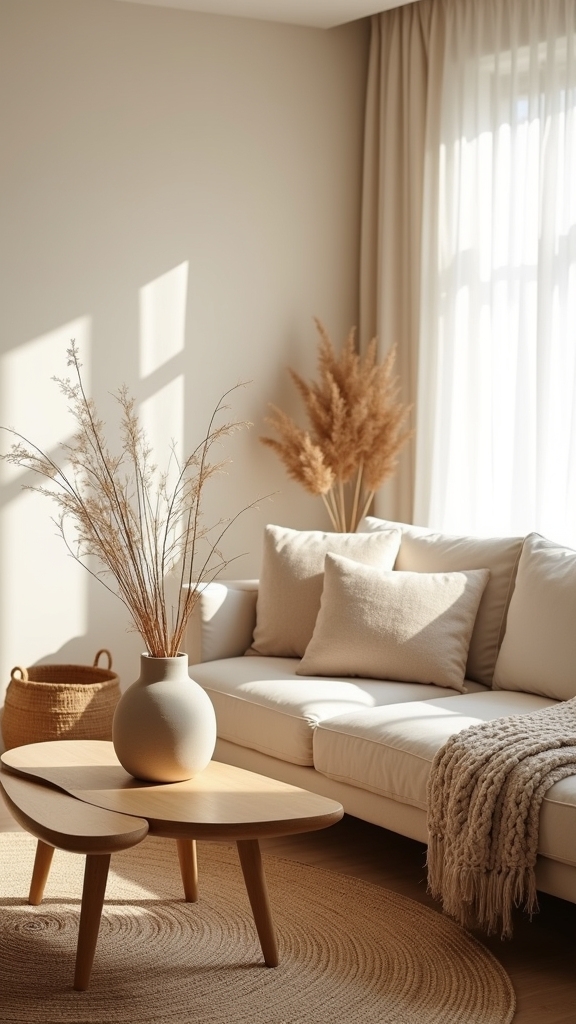
Building upon the tactile richness of wooden elements, minimalist beige design distills the living room to its purest form, favoring a monochromatic palette that emphasizes tonal harmony and spatial serenity.
This approach, increasingly prevalent in neutral living room ideas, utilizes a spectrum of beige tones to cultivate a warm yet uncluttered ambiance. The interplay of textures—such as plush throws, woven rugs, and smooth ceramics—adds depth and tactility while preserving visual restraint.
Sleek, contemporary furnishings with clean lines reinforce the minimalist ethos. Abundant natural light, filtered through sheer curtains and reflected by soft surfaces, enhances the sense of openness and tranquility.
To effectively achieve minimalist beige design:
- Layer varied textures for subtle dimension.
- Maximize natural light for warmth.
- Integrate greenery for organic contrast.
Highlight With Bold Accent Colors
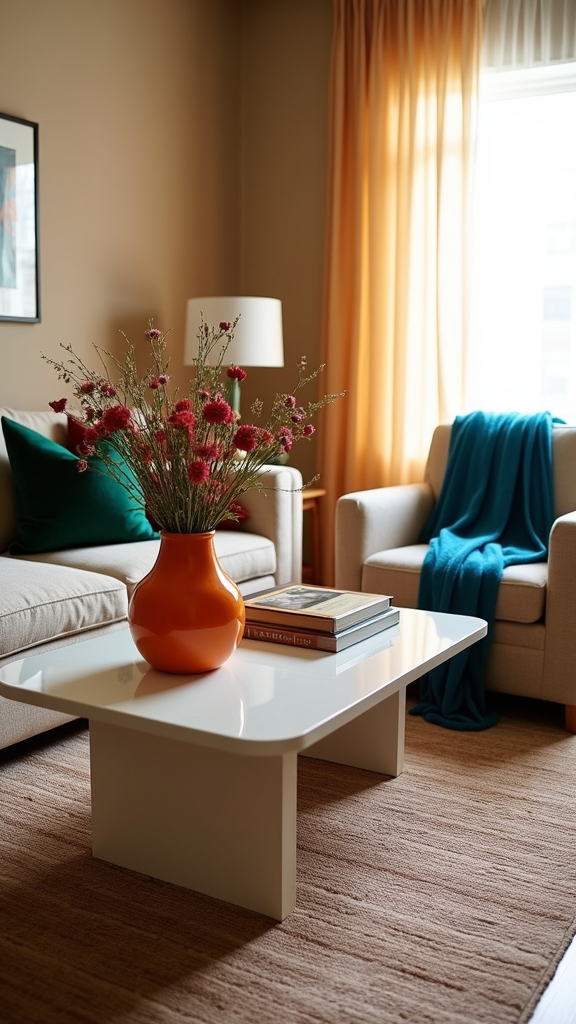
A strategic use of bold accent colors—such as sapphire blue, emerald green, or vibrant crimson—catalyzes visual intrigue within a beige living room, transforming its subdued palette into a sophisticated canvas for expressive design.
By juxtaposing bold accents against neutral beige, designers achieve striking contrast that raises the room’s overall visual appeal. Accent colors can be thoughtfully integrated through textiles, such as cushions and rugs, or through curated colorful elements like modern art, sculptural vases, and statement lighting.
These interventions not only energize the space but also delineate distinct zones within open-plan layouts, fostering pockets of intimacy and interaction.
Contemporary research underscores that the infusion of accent colors into neutral environments enhances warmth and mood, making the beige living room both visually compelling and inviting.
Incorporating textural variety through diverse materials like luxurious velvet and natural wood can further enrich the design, adding depth and a tactile experience to the living space.
Bring in Natural Light
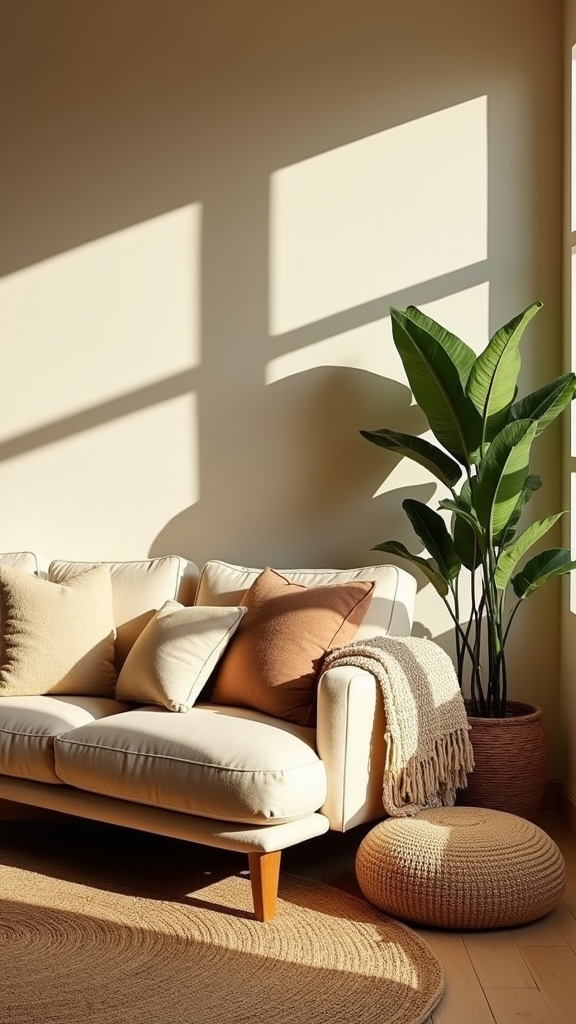
Optimizing window exposure is essential for amplifying the inherent luminosity of beige living rooms, as unobstructed sunlight accentuates the warmth of neutral tones. Incorporating sheer curtains remains a favored design approach, balancing privacy with an airy, contemporary aesthetic. This strategy not only enhances visual spaciousness but also aligns with current trends emphasizing natural illumination and open, welcoming interiors. Additionally, soft ambient lighting can elevate the cozy ambiance, especially when mixed with warm whites like cream or ivory, to create a serene and inviting atmosphere.
Maximize Window Exposure
When natural light is thoughtfully maximized in a beige living room, the space is instantly enhanced with warmth and an inviting, luminous quality.
To achieve this improved ambiance, design experts recommend optimizing window exposure to amplify the influx of sunlight. This not only enriches the beige palette but also infuses the room with a soft glow, emphasizing both comfort and spaciousness.
Key strategies include:
- Place mirrors strategically opposite windows to reflect and disperse natural light, visually expanding the space.
- Incorporate light-colored or glossy surfaces—such as lacquered tables or metallic accents—to intensify brightness and add modern vibrancy.
- Maintain landscaping around windows by trimming trees and bushes, ensuring that natural light is not obstructed and that the warmth permeates the living area continuously.
This approach creates a trend-forward, radiant environment.
Use Sheer Curtains
Building upon the impact of abundant natural light, sheer curtains emerge as an elegant solution for softening sunlight while enhancing the luminous quality of a beige living room. The translucence of sheer fabrics allows daylight to filter through, improving the inherent warmth of beige tones and supporting a bright, airy ambiance.
Opting for sheer curtains in light colors—such as cream or soft white—maintains visual cohesion and raises the sophisticated, tranquil aesthetic typical of modern beige interiors. Expert designers recommend layering sheer curtains with heavier drapes to introduce depth and texture, offering both versatile light control and heightened visual interest.
This approach not only guarantees privacy but also accentuates the cozy feel of the space, aligning with contemporary preferences for inviting, comfort-driven living room environments.
Choose Statement Beige Furniture
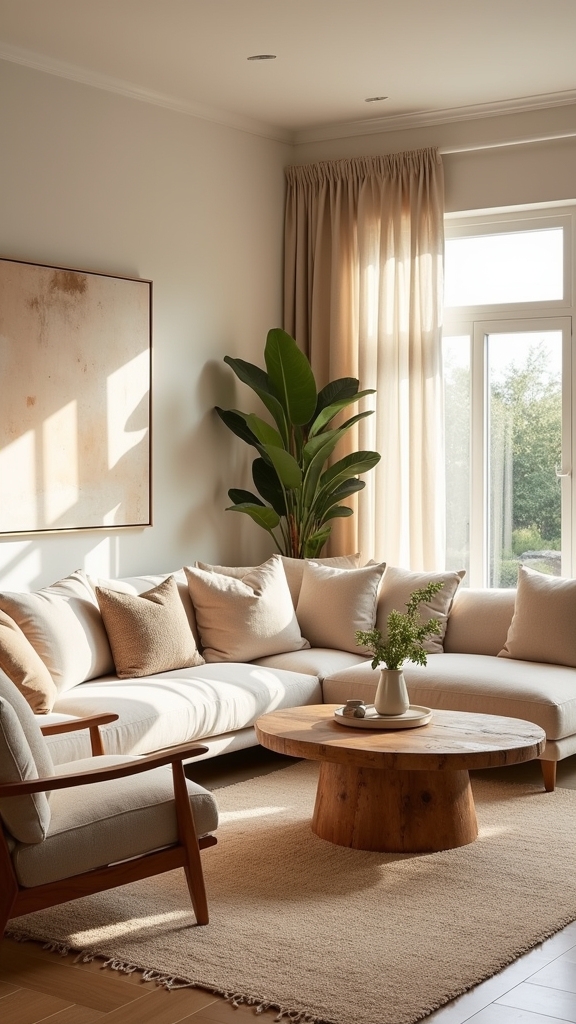
Selecting statement beige furniture introduces both visual impact and enduring elegance to a living room scheme.
A statement beige sofa—perhaps a plush sectional or a tufted silhouette—anchors the space, combining comfort with sophisticated versatility.
Expertly chosen beige furniture, such as unique beige accent chairs or a bespoke coffee table, adds individuality while maintaining a harmonious palette.
The use of textured fabrics, including velvet or linen, layers tactile interest and exudes inviting warmth, transforming the seating into a cozy arrangement ideal for relaxation and conversation.
Textured fabrics like velvet or linen bring layered warmth and tactile charm, making seating irresistibly cozy and welcoming.
For those seeking a curated aesthetic, custom or hand-carved beige pieces enhance the ambiance and offer personalized distinction.
- Opt for a statement beige sofa to create a focal point.
- Introduce unique beige accent chairs for added visual intrigue.
- Select textured fabrics to improve warmth and depth.
Play With Patterns and Prints
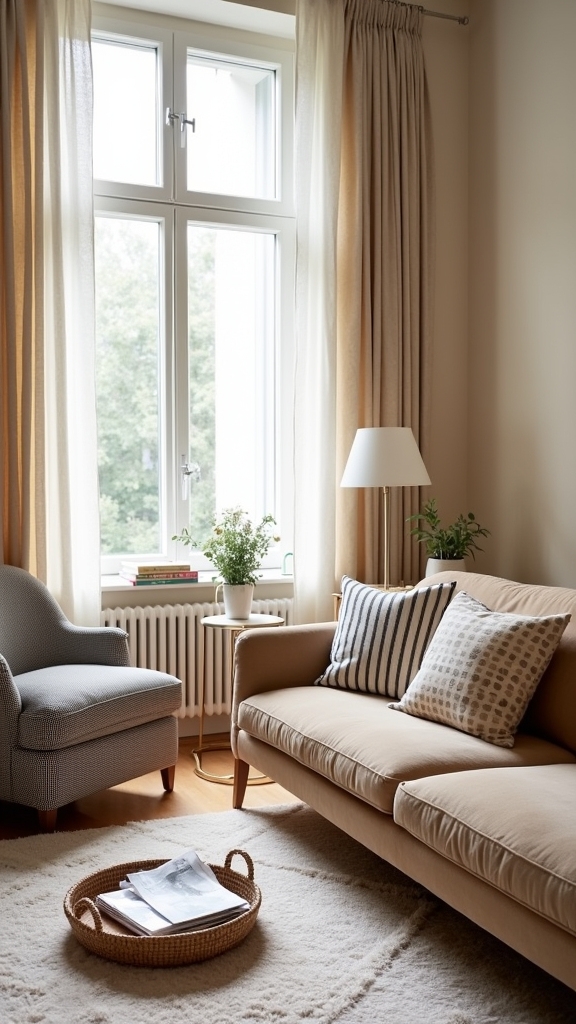
With a foundation of statement beige furniture established, introducing patterns and prints enhances the visual narrative of the living room.
Patterned rugs—geometric or floral—infuse visual interest and anchor the space, aligning with current interior trends that favor layered warmth. Layering throw pillows in diverse patterns and tactile fabrics creates multidimensional depth, ensuring the neutral palette remains engaging yet balanced.
A textured wall, either subtly embossed or adorned with delicate stenciling, offers a refined backdrop for these visual elements.
Patterned curtains introduce gentle movement and pattern play, softly diffusing light and accentuating the room’s harmonious tones.
Accent pieces, such as sculptural vases or intricately designed bowls, punctuate the décor, drawing the eye and reinforcing the inviting, curated ambiance synonymous with trend-forward beige living rooms.
Add Greenery for Freshness
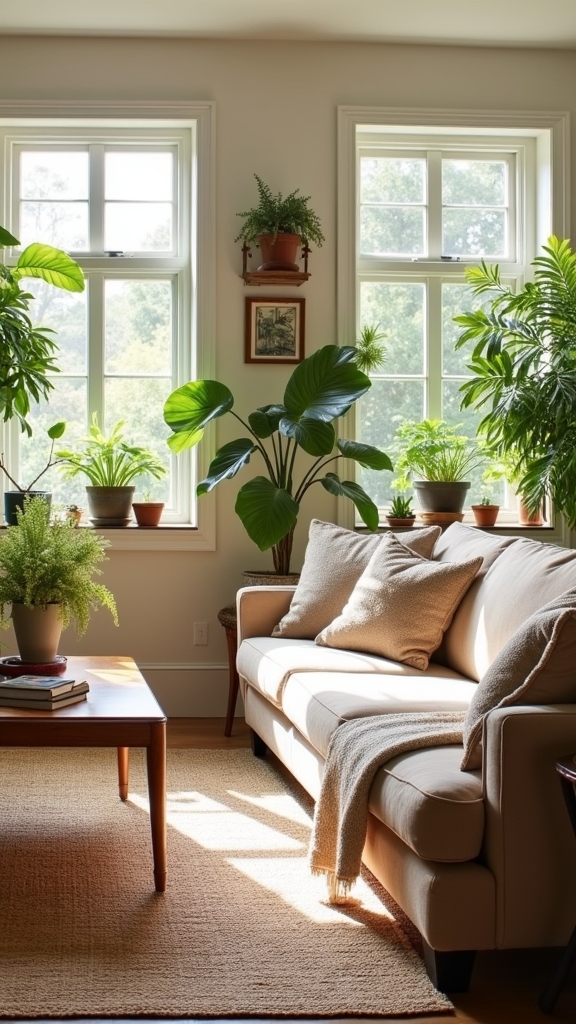
A sculptural monstera or sleek snake plant instantly enlivens a beige living room, introducing organic form and a revitalizing palette shift that punctuates the neutral scheme.
Indoor plants serve as both biophilic accents and functional enhancers of air quality, making them a staple in contemporary design.
To amplify visual appeal, designers recommend layering greenery in diverse scales—from towering floor specimens to petite potted succulents.
Contrasting planters, such as matte terracotta or glazed ceramics, contribute additional texture and color interplay without overwhelming the calm neutrality of beige.
For a curated, trend-forward look, consider these strategies:
- Mix tall plants with trailing varieties to create dimensional interest.
- Select planters in unexpected finishes for added sophistication.
- Rotate in seasonal bouquets for transient bursts of color and freshness.
Accentuate With Metallic Touches
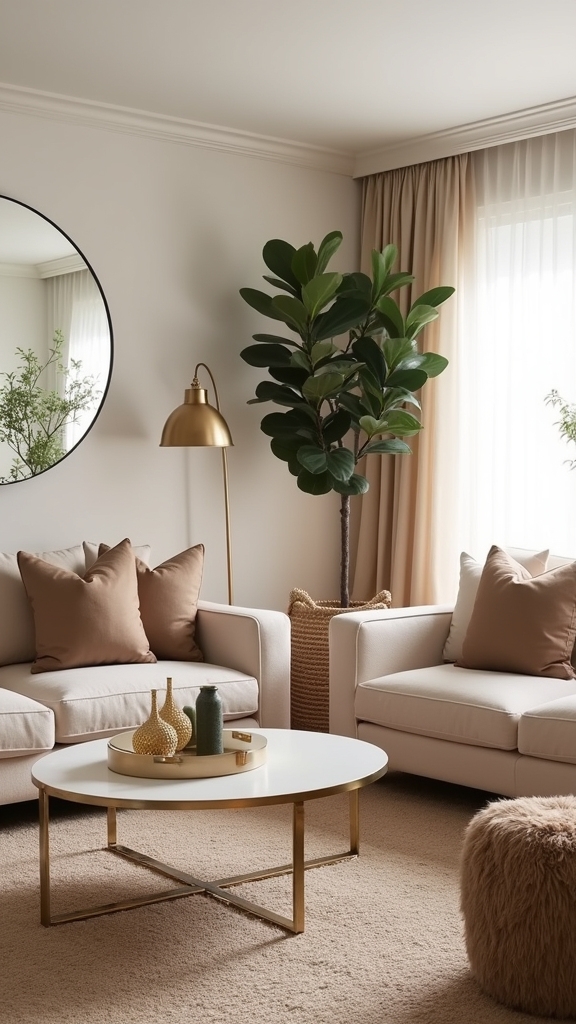
While beige establishes a serene and versatile canvas, introducing metallic accents—such as gold, brass, or brushed nickel—infuses the living room with refined luminosity and contemporary edge.
Metallic touches in decor items like picture frames, sculptural lamps, or sleek vases amplify visual interest, creating dynamic contrast against neutral tones.
Integrating metallic textiles—subtly shimmering cushions or throws—layer in depth and a hint of sophistication without compromising the inviting interior’s warmth.
Strategic placement of these finishes, whether matte for understated elegance or polished for bold impact, draws the eye and serves as effective focal points.
This interplay of reflective and matte surfaces not only enhances the space’s aesthetic but also aligns with current design trends favoring harmonious blends of warm hues and statement-making materials.
Use Art and Decor for Visual Interest
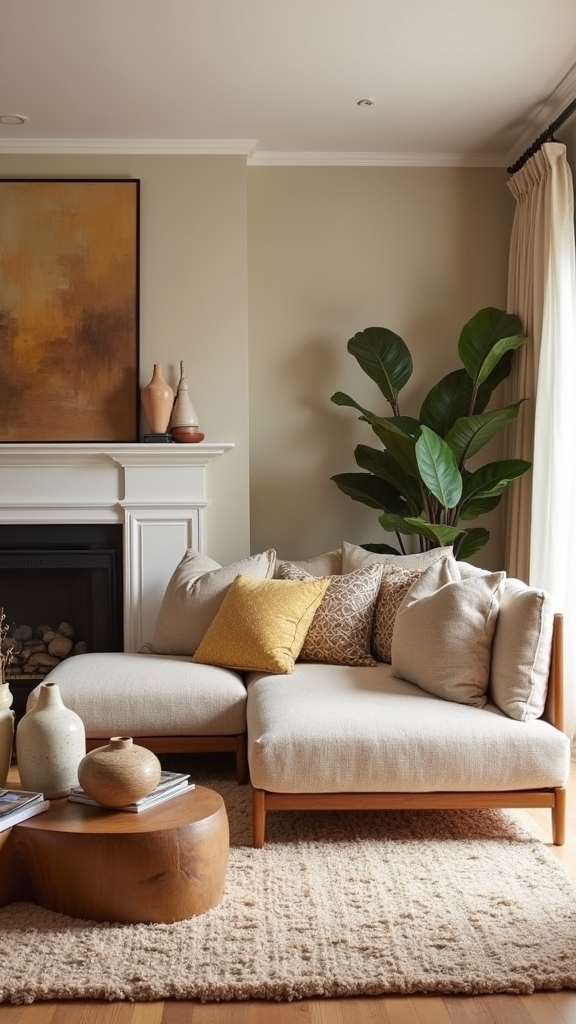
Elevating a beige living room’s ambiance, curated art and thoughtfully selected decor act as pivotal tools for injecting visual interest and depth. Incorporating art pieces—such as abstract paintings or sculptural forms in contrasting hues—establishes focal points that break monochromatic monotony and enrich the visual field.
Decorative elements like tactile vases, patterned throw pillows, and woven baskets foster texture, contributing layers that amplify warmth and invite sensory engagement. Wall art in warm or earthy tones harmonizes with beige while introducing dynamic contrast, further accentuating the room’s character.
To advance personalization and trend relevance, a gallery wall with mixed frames delivers an eclectic, curated aesthetic.
- Select contrasting art pieces for bold focal points.
- Layer decorative elements for enhanced texture and warmth.
- Create a gallery wall for eclectic visual interest.
Frequently Asked Questions
How Do You Add Warmth and Texture to a Room?
To add warmth and texture to a room, designers recommend layering cozy textiles, integrating layered lighting, incorporating natural elements, selecting decorative accents, and choosing warm finishes. These expert techniques create visual interest, tactile richness, and on-trend ambiance.
How to Make a Beige Room More Interesting?
A beige room achieves enhanced visual interest through the strategic use of beige accent pillows, textured wall art, and layered rugs. Decorative throws and contrasting furniture introduce dynamic interplay, blending tactile variety with trend-forward sophistication for a curated aesthetic.
How to Make a Beige Living Room Pop?
To make a beige living room pop, designers recommend integrating beige accent pieces with contrasting furniture, vibrant artwork, and playful patterns. Layered textiles further amplify visual depth, aligning the space with current trends in dynamic, textured interiors.
What Colours Go With Beige in a Living Room?
When considering what colours go with beige in a living room, experts recommend incorporating neutral color palettes, selecting accent color choices with warm undertones, and balancing complementary hues. Color psychology suggests jewel tones and soft pastels enhance visual interest and trend appeal.
Conclusion
Beige living rooms transcend neutrality when layered with tactile textures, tonal variations, and curated accents. Expertly blending warm undertones, organic elements, and metallic highlights introduces depth and visual intrigue. Contemporary trends favor dynamic pattern play, strategic greenery, and thoughtfully chosen art to invigorate beige palettes. Ultimately, these design strategies transform beige from basic to sophisticated, making it a versatile backdrop that radiates both comfort and modern elegance. The result: a timeless, trend-forward space with enduring appeal.
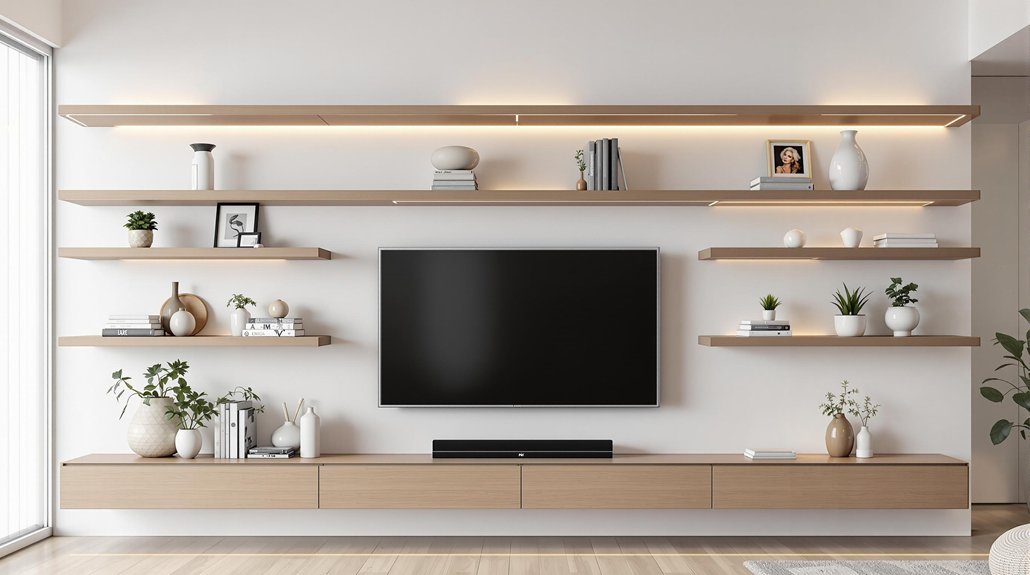
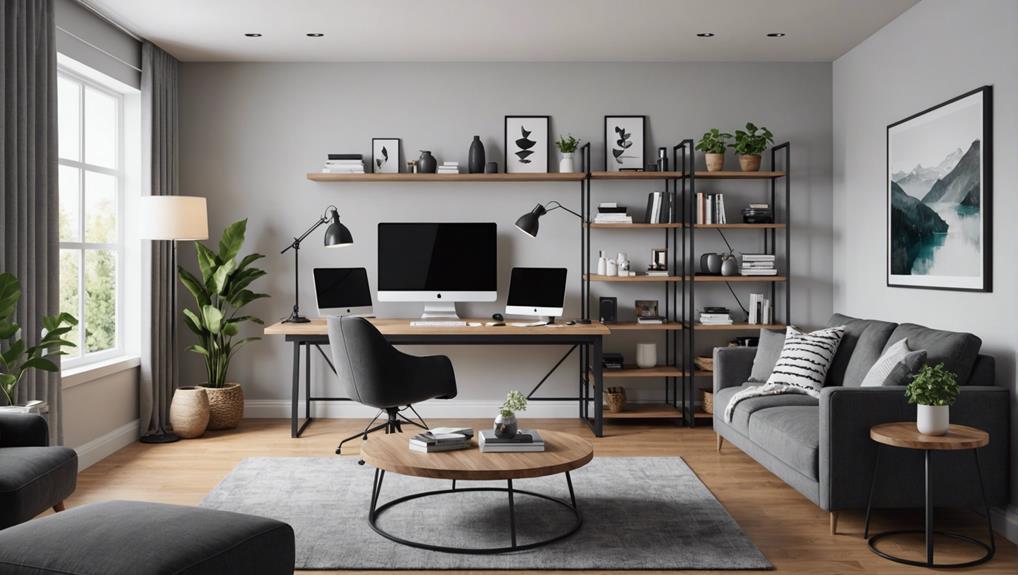
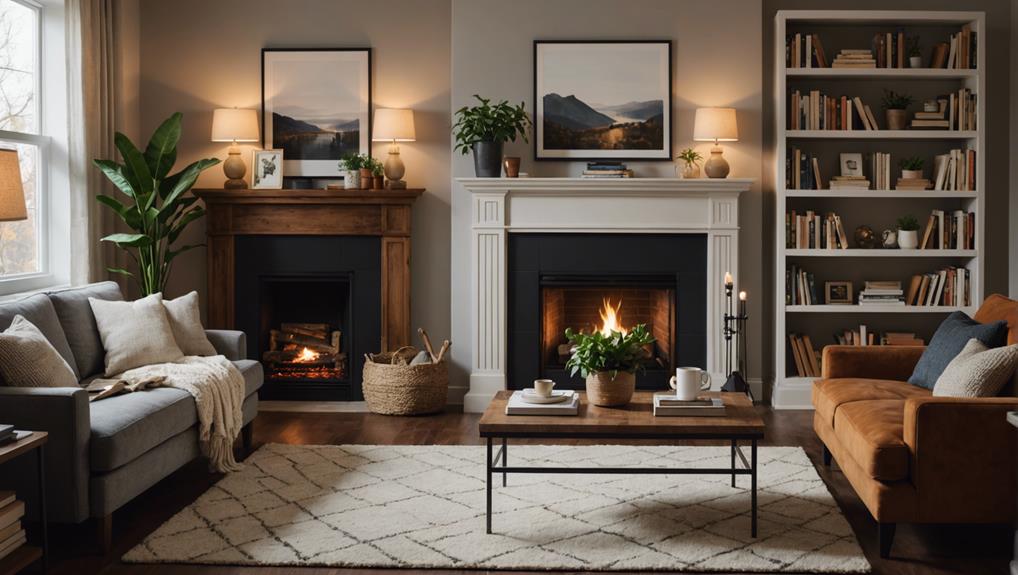
Leave a Reply